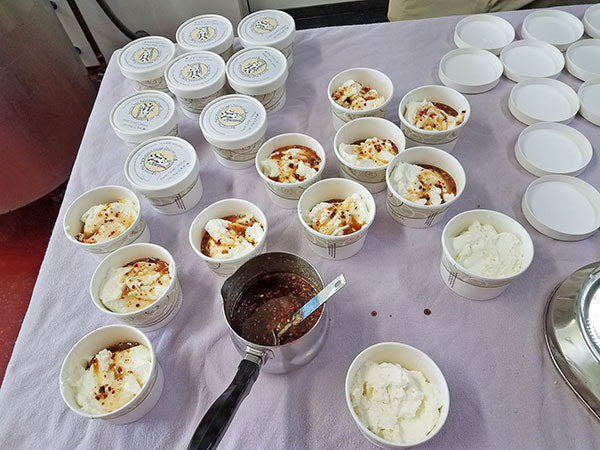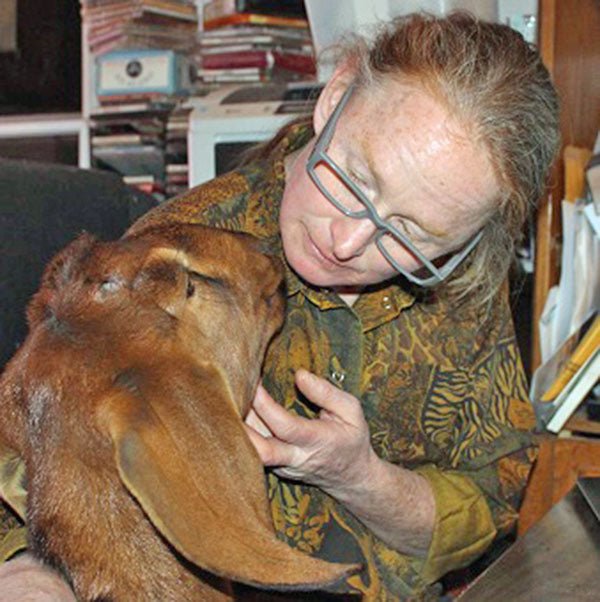
Karin Eide with Helga and Horchata next to a mostly munched thistle plant. Border Collie Ruby is keeping a watchful eye.
We first heard from Karin Eide in Bayside, California when she asked us to add her to our list of cheese makers in the US who use thistle rennet (click here). She told us she has been importing it from Spain and using it exclusively (as her only rennet) for the last 8 years. She uses it in all her cheeses – fresh, aged cheddars (up to 60 days), feta and everything in between.
This is very unusual because thistle hasn’t been used much in the US, perhaps because it is best used with goat and sheep milk. Hopefully that will change because we (and other cheese making suppliers) are carrying it now (click here).
Karin was definitely a maverick when she first started using it and she remains one of only a few cheese makers who use it in their products. We wanted to know more about her…

Karin at the Bayside Community Center in December
How did you end up raising goats?
I grew up in the Bay Area by San Francisco as a first generation American. When I think of who I am I always think of my parents, a Norwegian father and a Mexican mother.
I spent summers in Norway, living in the village with my grandparents on the fjords of western Norway (my mom worked for the airlines and we would fly for $100 round trip!). My grandmother was an amazing woman and taught me how to knit when I was 5 years old. She inspired me in so many ways – she was a true Renaissance woman.
When I was 20, I moved to Humboldt County (northern California) for five years and when I was 25, I moved to Norway for 5 years. I studied traditional Scandinavian weaving at a trade school and opened a weaving studio in Old Stavanger with a classmate.

A few place mats and table cloths Karin wove

4 x 6 weaving with painting of Bonita, her herd queen in front. The painting was done by a friend, Tucker Calhoun, as a gift.
I had always been drawn to the traditional crafts and was recently told my great grandmother had made cheese when she was younger. Last year, on a family visit, I even saw her huge copper kettle!
After returning to Humbolt County at age 30, I had my daughter Kristina (now almost 27) and worked at a CPA firm – very long hours but good pay. I didn’t have much time for hobbies, but my daughter and I fulfilled our lifelong dream of having horses. We found some land with pasture close by our house and moved our horses there.

2008 on a weekend horse camping trip with her daughter, Kristina.
After 3 years of paying $50 a month for the land, it came up for sale and we were able to buy it with help from my dad who was a real estate investor. There were blackberry brambles and lush vegetation and a dense forest that the horses wouldn’t touch. When I was in escrow I told my dad, “Hey – I should get goats and make cheese!” He laughed and said “you have to milk them twice a day,” and I said EWWW, I don’t want to do that!
And then, EXACTLY one year later, there I was milking a La Mancha, Vera, and making cheese! For the following 5 years, I tried every type of starter kit sold by NECS and I made cheese in my kitchen with the few gallons of milk I had every week. I loved it!

I am retired from the CPA firm now, after almost 27 years, and in my second year as a California licensed goat dairy and cheese maker!
To date, I have a small herd of registered La Mancha dairy goats; 17 milkers, 8 dry yearlings and 8 doelings.

Looking at their guard dog in February. (You can see in the back that their cheese is made using solar power. 28 voltaic and 2 hydro solar panels sit on the main house and power the house, dairy and cheese making.)
I sell my cheese primarily at the Arcata Farmer’s Market, Eureka Old Town Night Market, Kneeland Glen Farmstand down the road and one of the best restaurants in Eureka serves my cheese. My long term plan is to do this for the next 20 years, milking a maximum 30 goats (once a day) and branching out to more farmer’s markets locally and possibly starting a CSA in partnership with local farms, since we are not open to the public at our farm.

Susan Elliot (“awesome helper!”) at the Arcata Farmer’s Market with Karin who took this pic.
I LOVE what we have here and couldn’t ask for a better life. And, as for my Mexican heritage, all of my goats have Latina names and most of my cheeses, too!

Spring Hill is a WWOOF host farm. (That is Karin in the pic.)

Sammy Faires, a Farmstead resident, holding two new gopher hunters.
You’re retired!?
I’m having so much fun as a farmstead goat cheese producer and farmer! I counted working hours for a few weeks and find I average 14 – 21 hrs a day.

I am in the right place, at the right time, doing the right thing! This is my working retirement and I’m just starting my second year of business (have been raising dairy goats 14 years and making cheese the last 10)! I am 57, so I figure I have 20 years to do this, then I’ll try something new (like maybe relaxing a little!).

Karin starts every morning with a spicy Mexican goat mocha.
What kind of cheese are you making?
Fresh (chevre) in 4 flavors (including one sweet and one classic unflavored), whole milk ricotta in 3 flavors (Meyer lemon, apple cider vinegar, rosemary), Mexican cheddars in 3 flavors (both aged and squeaky curd fresh), whey ricotta and gjetost from the 3 flavors of Mexican cheddars), bloomy rinds, marinated feta in 2 flavors, feta in brine, and more to learn but the above are currently sold weekly at farmer’s markets.

Besitos, little bloomy rind hearts, aging for market.

Mexican cheddar cheeses aging for market. “¡Ai Chihuahua!” for her mom born in Chihuahua Mexico and “Gringo” which she created for her Dad on his 80th birthday.

Fiesta feta hearts
We have an original blend of herbs, spices and seaweed that are highlighted in several of the cheeses. We have our own honey that is infused with various single herbs (from the farmstead) or spices for our sweet of the week.

Adding their original blend of roasted farmer’s market chili’s infused in Spring Hill honey to their whipped fresh goat cheese.
This is a new business?
April 1, 2017 was the start of Spring Hill Farmstead Goat Cheese LLC and I’m still putting in finishing touches. The carpenter is here now putting more shelving in the milk parlor and cheese room. I’m getting organized now that I have an inkling of production flow and storage needs.

Karin teaching a friend to make a ZERO waste cheese in 3 stages… cheddar, ricotta, gjetost… all from the same milk!

Karin’s sweetie, Tim O’Leary turning Besitos.

Pressing the Mexican cheddar cheeses.

A small batch of Gringo Mexican cheddar, fresh from pressing.

Susan Elliot in front of the special farmer’s market peppers used in their cheeses. They use 30 kinds of chili’s – some sweet, mild, crazy hot, etc.

Cisca Harriss milks the goats 3 mornings a week so Karin can make cheese and also helps pack cheese. Here she is packaging the feta in marinated oil.

Cisca wrapping the drunken goat cheese. They harvest local fig leaves and macerate them in wine for 6 months before wrapping them around a disk of fresh cheese and aging for two weeks.

Fresh cheese hanging overnight to drain. It gets whipped with sea salt before flavoring with their original herb, spice and seaweed blend for market.
How did you decide to use thistle rennet?
I started using thistle rennet about 8 years ago. I had read something somewhere about making it and I had very healthy thistles growing in my pastures. I rotate pastures so they had a chance to thrive if left alone. We harvested the whole flower/seed head and ended up with a corner of the garage piled high with the bursting seed pods (think dandelion heads x 5). At that point, I was still interested in trying thistle rennet, so I purchased some and never looked back!
Then, I found it online through a supplier in New York who imported it from Spain. A couple of years ago, just as I was finishing construction on the micro dairy, it was no longer available and I contacted a foodie friend in Spain for help. He was able to give me the Spanish name for thistle rennet and from there I found a WONDERFUL woman, Mafalda of Quesos Caseros, who is now supplying me with fresh thistle rennet. It is just divine! The shelf life, refrigerated, is just 6 months.
I have not tried your thistle rennet yet, but plan to. It is very expensive shipping from Spain so I had ordered a large amount and still have a large bottle left.
How does thistle rennet compare to others?
I used the vegetable rennet tablets from NECS the first couple of years and was happy with the resulting cheese, but there is just something special about thistle rennet. Fresh thistle rennet smells earthy and sweet and is just amazing. I have used it exclusively for so many years, I’m not sure I could compare the results. There was an excellent article in Culture magazine awhile back discussing the merits of thistle rennet cheeses (click here). I wish I could be so eloquent!

Aging Mexican cheddars are vacuum sealed to protect against bloomy rind molds.
Do you make your cheese any differently with thistle rennet?
When I first started using it years ago, I following the single strength guidelines, not really knowing any better, and have always been successful. I know when using this rennet, it needs a bit more stirring and longer coagulation for a nice firm curd (and I always use calcium chloride). I have only used it with goat and sheep milk and I’ve never had any issues with the cheese make process or bitterness.

Using a tryer to core sample aging Mexican cheddars.
What are your goals now?
Goat farming and cheese making is my whole life. I am getting the farm set so I can travel to Spain, France, Norway for cheese making inspiration and Cambodia to visit the school my dad started (Cambodia Academy at Mongkol Borei). Leaving the farmstead and business for 3 weeks is my 2 year goal and I have until fall of 2019!
Viva las Quesos!

In Cambodia with her dad, Hans and her daughter Kristina, visiting the school he started there.
Where to find her
Karin sells her Farmstead cheeses at two farmer’s markets weekly – (Arcata and Eureka) and at the Kneeland Glen Farmstand (Eureka.) Her cheese is served at the Hotel Carter 301 restaurant (Eureka).

With a Spring Hill Farmstead resident, Mary Ellen Lee, at the Arcata Farmer’s Market.
Karin Eide
Spring Hill Farmstead Goat Cheese LLC
707-616-1093
springhillfarmstead@gmail.com















































































































































